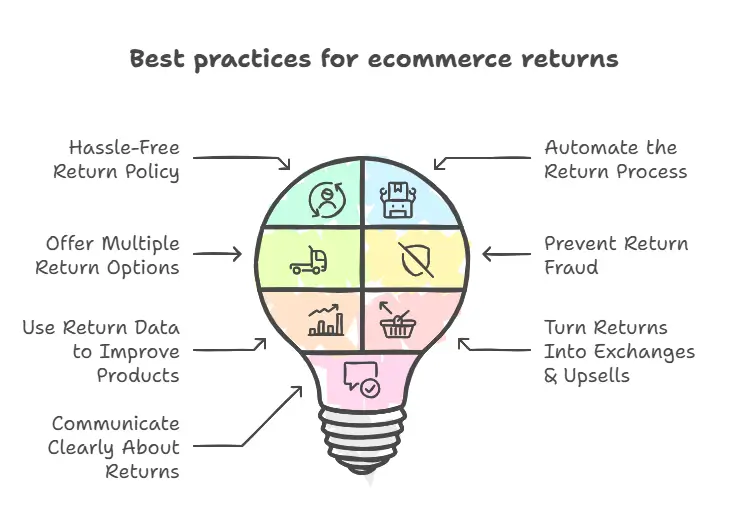Ecommerce returns are a big deal. The average ecommerce return rate is between 20-30%, depending on the industry. For online retailers, a poor returns process can mean lost sales revenue, lower customer satisfaction, and shrinking profit margins. On the flip side, a good returns management process can turn customer returns into future sales and build customer loyalty.
What do customers expect? Simple—hassle-free returns, clear return policies, and fast refunds or store credit. Ecommerce brands that meet customer expectations in this area often see repeat customers and higher customer lifetime value. But offering free returns isn’t always possible, especially for small ecommerce businesses trying to manage costs.
So, how do you create a returns process that keeps customers happy while protecting your profit margins? In this guide, we’ll cover 7 best practices for ecommerce returns, from reverse logistics to using returns management software. Plus, we’ll share pro-tips to help ecommerce companies reduce returns and increase customer satisfaction.
7 best practices for ecommerce returns

1. Hassle-Free Return Policy
A good ecommerce return policy is clear, easy to find, and simple to follow. Online shoppers want to know exactly how long they have to return an item, whether free return shipping is available, and if they can get store credit, a refund, or an exchange.
What Customers Expect in a Return Policy
- A clear return window – Most ecommerce retailers offer a 30-day return window, but some ecommerce brands extend it to 60 or 90 days to increase customer loyalty.
- Easy-to-follow instructions – Customers should know how to return in-store, request a return label, or complete a return through an ecommerce website.
- Fast processing – How long customers wait for refunds impacts customer experience and future purchase decisions.
- Multiple return options – Some customers prefer to return in-store, while others want hassle-free returns via mail.
How to Improve Your Ecommerce Return Policy
- Offer store credit or exchanges instead of just refunds to keep customers shopping.
- Highlight free returns (if possible) on product pages to reduce uncertainty.
- Use return shipping solutions that allow customers to generate return labels easily.
- Keep customers informed with email or SMS updates about their returns process.
A hassle-free returns policy doesn’t mean accepting all returns without question. Ecommerce businesses need to find a balance between meeting customer expectations and protecting their profit margins.
2. Automate the Return Process
Handling customer returns manually can overwhelm your customer service team and slow down refunds. Ecommerce returns management software can simplify the reverse logistics process, helping ecommerce businesses process returns faster while reducing errors.
How Automation Improves the Returns Process
✅ Speeds up return approvals – Customers don’t want to wait. Automated returns management software can instantly approve eligible returns based on your ecommerce return policy.
✅ Creates return labels instantly – Letting customers generate their own return labels speeds up the shipping process.
✅ Improves inventory management – Automated systems update customer orders and restock returned items quickly.
✅ Reduces return fraud – Automation tools help flag return fraud by detecting suspicious patterns.
Pro Tip
- Use returns management software that integrates with your ecommerce site to track customer requests and keep customers informed.
- Automate refund processing to increase customer satisfaction and encourage future sales.
3. Offer Multiple Return Options
One major advantage brick and mortar stores have over ecommerce retailers is easy returns. To match that convenience, ecommerce companies should offer multiple return methods.
What Customers Expect
📦 In-store returns – Many shoppers prefer to return in-store for immediate refunds.
📦 Drop-off locations – Some prefer returning items at designated drop-off points instead of mailing them.
📦 Mail-in returns – A must-have option for online purchases.
Pro Tip
- Offer free shipping on returns when possible to increase customer loyalty.
- Use a returns process that includes multiple options to match customer expectations and improve the customer experience.
4. Prevent Return Fraud
Return fraud costs ecommerce retailers billions annually. Common scams include returning used or stolen items, exploiting free return shipping, or abusing store credit policies.
Ways to Prevent Return Fraud
🚫 Use serial number tracking to prevent fake returns.
🚫 Require return approvals for high-value items.
🚫 Limit return windows for fast-moving products.
🚫 Flag repeat returners to detect potential abuse.
Pro Tip
- Set different return windows based on product type. Ecommerce businesses can offer free shipping on returns for certain categories while limiting high-risk items.
5. Use Return Data to Improve Products
Returns aren’t just a cost—they’re a learning opportunity. Ecommerce brands can use customer returns data to increase customer satisfaction and reduce future return rates.
How to Use Return Data
📊 Find product defects – If multiple customer orders are returned for the same reason, there may be a quality issue.
📊 Improve product descriptions – Detailed product pages help meet customer expectations and reduce misunderstandings.
📊 Adjust inventory management – Identify which products have high return rates and adjust stock levels accordingly.
Pro Tip
- Share common return reasons with your customer support team to improve responses and reduce returns.
6. Turn Returns Into Exchanges & Upsells
Instead of treating returns as lost revenue, ecommerce businesses can use them to drive future sales.
Strategies to Convert Returns Into Sales
🔄 Offer store credit – Customers who choose store credit over a refund are more likely to make a future purchase decision.
🔄 Suggest alternative products – Instead of a refund, suggest a similar item at a discount.
🔄 Give return incentives – Offer a discount on a future purchase if they choose an exchange instead of a refund.
Pro Tip
- Make it easy for repeat customers to exchange items, keeping them engaged with your ecommerce store
7. Communicate Clearly About Returns
Keeping customers informed is key to a great customer experience. Online shoppers want real-time updates on their returns process, refund status, and return shipping timelines.
How to Improve Communication
📧 Send automated emails at each stage of the return.
📦 Allow tracking for returns so ecommerce customers know when their refund is processed.
☎ Train your customer service team to handle return-related inquiries efficiently.
Pro Tip
- Add a return policy section on product pages to set clear expectations before the purchase.
Final Thoughts & Key Takeaways
A good returns management process is critical for maintaining customer satisfaction, profit margins, and future sales. While ecommerce businesses can’t eliminate returns entirely, they can manage returns in a way that builds customer loyalty and reduces costs.
Key Takeaways:
✅ A hassle-free return policy improves customer retention and encourages repeat customers.
✅ Returns management software helps automate approvals, track customer orders, and speed up refunds.
✅ Offering multiple returns process options—return in-store, mail-in returns, or drop-off locations—enhances the customer experience.
✅ Return fraud can be reduced with tracking systems, return approvals, and limited return windows.
✅ Return data helps improve product pages, inventory management, and reverse logistics.
✅ Encouraging store credit or exchanges can turn customer returns into future purchase decisions.
✅ Clear communication keeps customers informed and reduces confusion during the returns process.
By implementing these best practices for ecommerce returns, ecommerce brands can increase customer loyalty, improve customer experience, and drive repeat sales.
FAQs on Ecommerce Returns
1. How do I reduce return rates in my ecommerce store?
To reduce return rates, ensure product pages have accurate descriptions, clear images, and sizing guides. Implement a hassle-free returns policy that encourages exchanges instead of refunds. Offering store credit can also motivate future purchases and lower the return rate.
2. What is the best return policy for small businesses?
Small businesses should balance customer expectations with operational costs. Consider a 30-day return window with options for store credit, exchange, or refund. Offering free return shipping selectively—such as on damaged items—can also be effective.
3. How do I prevent customers from abusing my return policy?
To prevent return fraud, use returns management software to track returns, require receipts or proof of purchase, and set limited return windows. Identify repeat customers with high return rates and flag suspicious behavior.
4. Should I offer free returns for my ecommerce store?
Offering free returns can boost customer satisfaction and customer lifetime value, but it’s important to weigh the costs. Free returns are more feasible for high-margin products or repeat customers. Consider offering free return shipping for exchanges or store credit instead of full refunds.
5. How can ecommerce businesses turn returns into sales?
Encourage customers to choose store credit over refunds by offering incentives like discounts on future purchases. Use automated emails to suggest alternative products or upsells. Ensure online shoppers can easily make exchanges to drive repeat sales.
6. How long should customers wait for a refund?
Most ecommerce companies process refunds within 5-10 business days after receiving the returned item. Keeping customers informed with email updates can reduce anxiety and improve customer experience.
Conclusion
Returns are a reality for every ecommerce business, but managing them the right way can turn a challenge into an opportunity. A hassle-free returns process doesn’t just keep customers happy—it also builds customer loyalty and encourages repeat customers.
By implementing these best practices for ecommerce returns—from automating reverse logistics to offering store credit and multiple return options—ecommerce brands can improve customer experience, protect profit margins, and drive future sales.
The key is to balance customer expectations with business sustainability. A good returns management process ensures online shoppers feel confident making online purchases, leading to higher customer lifetime value and stronger sales revenue.
Want to improve your returns strategy? Start by optimizing your ecommerce return policy today!


